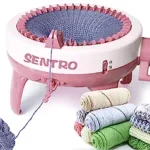Alright, imagine this: You're sitting in your favorite knitting spot, fully immersed in a mesmerizing world of stitches and yarn. You're knitting away on a cozy blanket for your best friend's birthday – a gift that's supposed to be a heartwarming surprise.
But as fate would have it, just when you're about to finish the last row of your yarn, disaster strikes! You run out of yarn, and your heart sinks faster than a pair of socks on a slippery floor. Panic sets in, and you're left with two choices: give up and pretend the unfinished gift is an avant-garde art piece, or figure out how to join yarn and salvage the situation.
Opting for the latter, you channel your inner MacGyver and attempt to tie a knot between the old and new yarn. But wait, it's not as simple as you thought. The knots look more like a yarn brawl, and your beautiful blanket is turning into a knotty mess.
With desperation, you turn to your knitting-savvy friend, who laughs and swoops in to save the day. They show you the proper way to join yarn, and it's like a yarn miracle. The joins are seamless, invisible, and knit-worthy.
With renewed confidence, you continue knitting, thanking the knitting gods for your friend's timely intervention. As you see the blanket coming together again, you realize the importance of knowing how to join yarn in knitting. It saves you from unraveling projects and prevents those awkward "Oh, I ran out of yarn" moments.
Now, with your yarn-joining superpower in hand, you're ready to face any knitting challenges. Your best friend will get the birthday gift they deserve, and you'll forever remember the day you defeated the yarn monster with a few simple tricks. Happy knitting, and may your yarn joins always be smooth and full of laughter!
How to Join Yarn in Knitting: A Seamless Transition for Knitting Success
In the wonderful world of knitting, yarn is the lifeblood that brings our creations to life. Whether you're crafting cozy scarves, stylish sweaters, or adorable baby booties, eventually, you'll find yourself in need of joining a new ball of yarn. But fear not! Joining yarn in knitting is a simple and essential skill that ensures your projects are seamless and polished. In this comprehensive guide, we'll walk you through various methods of joining yarn, step-by-step instructions, and helpful tips to make this process a breeze.
Why Joining Yarn is Important
Joining yarn is a crucial skill in knitting for several reasons:
- Continuous Work: By joining a new ball of yarn, you can continue knitting without interruption, creating a seamless and even fabric.
- Finishing Projects: When you run out of yarn in the middle of a project, knowing how to join yarn allows you to complete your masterpiece without unraveling.
- Professional Finish: Properly joining yarn ensures that your knitting projects have a neat and polished appearance, free from unsightly knots and lumps.
Choosing the Right Method
Before we dive into the step-by-step instructions, let's explore some common methods for joining yarn in knitting:
- Overlapping Method: This simple and secure method involves overlapping the old and new yarn ends and knitting a few stitches with both strands held together.
- Russian Join: The Russian join creates a seamless and almost invisible join by threading the new yarn through the plies of the old yarn.
- Weaving in Method: With the weaving-in method, you use a tapestry needle to weave the new yarn into the stitches of your work, creating a smooth transition.
Step-by-Step Instructions
Method 1: Overlapping Method
Step 1: When you're approaching the end of your yarn, leave a tail of approximately 6 inches.
Step 2: Attach the new ball of yarn by overlapping the tail of the old yarn with the beginning of the new yarn, leaving a small loop.
Step 3: Hold both yarn tails together in your left hand, and knit the next few stitches with both strands held as one.
Step 4: After knitting a few stitches, drop the old yarn tail and continue knitting with the new yarn.
Step 5: Once you've knit a few rows with the new yarn, weave in the old yarn tail on the wrong side of your work.
Method 2: Russian Join
Step 1: Unravel a few inches of the plies from the end of the old yarn to expose the individual strands.
Step 2: Repeat the same process with the new yarn, unravelling a few inches of plies.
Step 3: Thread the end of the new yarn through the plies of the old yarn, leaving a small loop.
Step 4: Thread the end of the old yarn through the plies of the new yarn, creating a crossover.
Step 5: Gently pull both ends to tighten the join.
Step 6: Trim the excess yarn close to the join, leaving a small tail.
Method 3: Weaving in Method
Step 1: When you're approaching the end of your yarn, leave a tail of approximately 6 inches.
Step 2: Using a tapestry needle, weave the new yarn tail through the stitches of your work, following the path of the existing stitches.
Step 3: Weave the new yarn for about 1-2 inches to secure it.
Step 4: Trim any excess yarn.
Tips for a Seamless Join
- Yarn Selection: Choose yarns with similar fibers, thickness, and color to achieve a smooth and invisible join.
- Avoid Knots: Knots are not recommended for joining yarn in knitting, as they can create bumps and uneven tension.
- Leave a Tail: Always leave a tail of approximately 6 inches when starting a new ball of yarn to ensure you have enough yarn to weave in later.
When to Join Yarn in Your Projects
You'll typically join yarn in various scenarios:
- Beginning of a New Row: If you run out of yarn at the end of a row, join the new yarn at the beginning of the next row to create a clean transition.
- Change of Color: When switching yarn colors in a striped or colorwork project, join the new color at the start of the desired row.
- Large Projects: For larger projects like blankets or sweaters, you may need to join yarn multiple times to complete the project.
Conclusion
Knowing how to join yarn in knitting is a valuable skill that ensures your projects are seamless and professionally finished. With methods like the overlapping, Russian join, or weaving-in techniques, you can confidently continue knitting without worrying about knots or disruptions. So, armed with your favorite yarn and knitting needles, embrace the art of joining yarn and embark on a world of endless knitting possibilities. Happy knitting, and may your yarn joins be smooth, seamless, and knit-tastic!
To find out more about knitting, please visit any of the following areas:
- How to sew together knitting
- What is brioche knitting
- How to join yarn in knitting
- How to join in the round knitting
- How to finish a knitting scarf
- How to make a slip knot for knitting
- How to switch colors knitting
- How to hold yarn when knitting
- What does kfb mean in knitting
- How to fix a dropped stitch in knitting
- How to hold knitting needles
- What is frogging in knitting?
- How to change colors in knitting
- How to count rows in knitting
- How to increase in knitting
- How to slip stitch knitting
- How to yarn over in knitting
- What is a knitting loom?
- How to make bobbles in knitting?
- Where can I buy sentro knitting machine?
- What can you make with a sentro knitting machine?
- Cricut Hat Press: A Comprehensive Guide on Usage - August 13, 2023
- Unlocking Creativity with the Cricut Joy: A Comprehensive Guide - August 12, 2023
- The Ultimate Guide to the Cricut Maker Bundle - August 11, 2023





